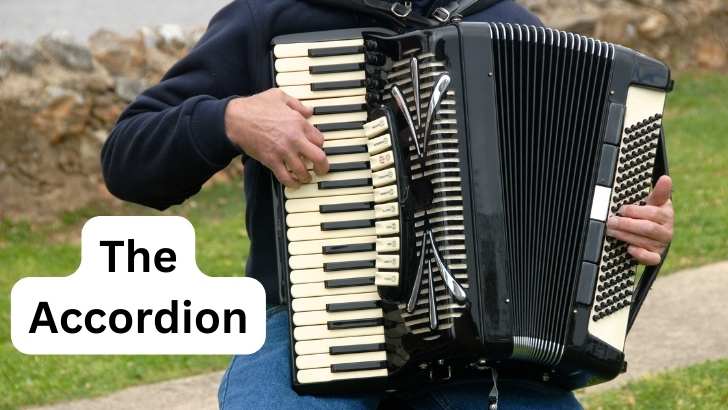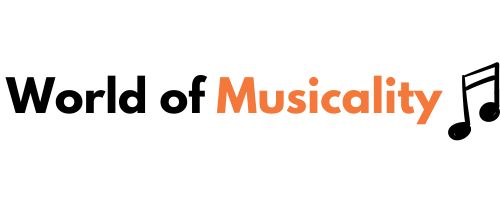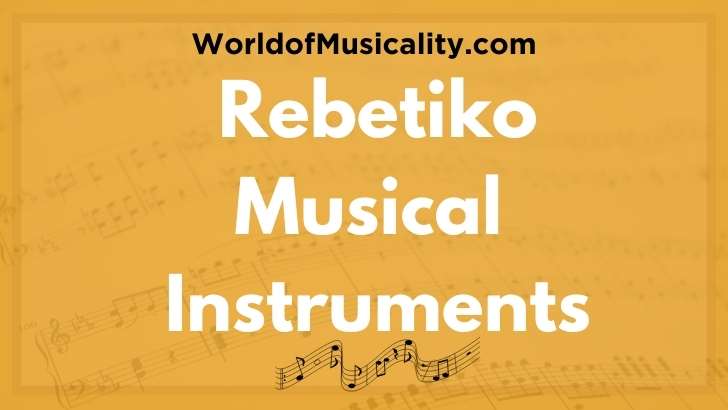
What is an Accordion Musical Instrument?
The accordion is a musical instrument that consists of a keyboard or buttons on one side, bellows in the middle, and bass buttons on the other side. To play it, a musician straps it to their chest, using their arms to press the keys or buttons while moving the bellows in and out. This action pushes air through reeds to produce a distinctive, melodious sound.
Accordion Instrument Facts
- There are several types of accordions, including the piano accordion, button accordion, and chromatic accordion.
- Button accordions have buttons on both sides instead of a keyboard.
- Accordions are widely used in genres like folk, polka, classical, jazz, and even rock music.
- The instrument’s weight varies from 2 to 18 kilograms (4.4 lbs to nearly 40 lbs), depending on the type and size.
- Standard dimensions also vary, with some concert accordions measuring up to 50 cm (20 inches) in height.
- The accordion is classified under the free-reed aerophone category in the Hornbostel–Sachs system because sound is produced by air flowing through reeds.
- The world’s most expensive accordion was sold for over $130,000.
- The first accordion is believed to have been invented by Friedrich Buschmann in 1822 in Berlin, Germany.
- Accordions can have anywhere from 24 to 120 bass buttons, offering a wide range of chords.
- The Stradella bass system is the most common bass button layout found in accordions.
- The Guinness World Record for the largest accordion ensemble features 1,693 participants.
- Accordions are part of traditional music in countries as diverse as Italy, France, Russia, and Mexico.
- Players of the accordion are commonly referred to as accordionists.
In this beginner’s guide, we’ll review what the accordion musical instrument is by examining what it sounds like, how it’s played, its long history, how it is made, and also explore some of the great tunes and compositions it has produced over its long and varied musical history.
What does an Accordion Instrument Sound Like?
The accordion produces a rich, resonant sound that can vary from deep, melancholic tones to bright, lively melodies, encapsulating a wide emotional range.
Watch the video below and hear the acordions unique musical sound firsthand.
How to Play the Accordion Instrument
The accordion, with its unique blend of harmony, melody, and rhythm, offers a distinctive musical experience.
This instrument is played by pressing keys or buttons while simultaneously operating bellows with the arms.
The left hand typically manages the bass and chord buttons, laying the foundation of the musical piece, whereas the right hand plays the melody on the keyboard or buttons.
Sound is produced in the accordion through a fascinating mechanism. Inside, it houses a series of reeds that vibrate when air, controlled by the bellows, flows over them.
The bellows act much like the lungs of the instrument, pushing and pulling air to create pressure changes.
This air movement is what brings the reeds to life, generating sound. The pitch of the note is determined by the size of the reed; shorter reeds produce higher notes, while longer reeds yield lower ones.
Players generate music by manipulating the bellows with precise pressure and movement, combined with strategic pressing of keys or buttons.
This dual action allows accordionists to craft rich, layered compositions that can range from simple melodies to complex, orchestral pieces.
The physical interaction between player and instrument is intimate, with the musician’s breath control and dexterity directly influencing the accordion’s voice, making each performance uniquely expressive.
Different Types of Accordion Instrument to Learn
There are several types of accordions that enthusiasts can learn to play, each with its unique characteristics and playing techniques. From piano accordions to button accordions, the variety caters to diverse musical tastes and preferences.
Piano Accordion
Features a piano-style keyboard on the right and bass buttons on the left.
- Pros: Familiar layout for those who already play the piano; versatile for various music genres.
- Cons: Can be large and heavy, making it challenging for some players to handle.
Button Accordion
Has buttons instead of keys on both sides.
- Pros: Compact design makes it easier to play complex music; lighter than piano accordions.
- Cons: Steeper learning curve for those not familiar with button layouts.
Chromatic Button Accordion
Arranged chromatically, allowing for a wide range of notes.
- Pros: Enables advanced players to perform complex pieces; compact and efficient.
- Cons: Requires time to master the chromatic system; not as intuitive for beginners.
Diatonic Button Accordion
Offers a bisonoric layout, meaning buttons produce different notes when pulling or pushing the bellows.
- Pros: Ideal for folk and traditional music; lightweight and portable.
- Cons: Limited to specific keys, which may restrict the repertoire.
Concertina
Smaller and hexagonal, played by pressing buttons and moving the bellows.
- Pros: Highly portable; suitable for folk music and sea shanties.
- Cons: Limited range of notes compared to larger accordions.
Bandoneón
Essential to tango music, with a complex button layout.
- Pros: Distinctive sound that’s crucial for authentic tango performances.
- Cons: Difficult to learn due to the non-standard layout of buttons and limited availability of instruments.
Each type of accordion offers a unique way to explore music, with choices depending on the player’s musical style, physical comfort, and desired sound.
Musical Origins of the Accordion
The name “accordion” originates from the German word “Akkordion,” derived from “Akkord,” meaning “musical chord, concord of sounds.” Introduced in the early 19th century, this term reflects the instrument’s ability to produce a harmonious blend of notes through its unique mechanism of keys and bellows.
Instrument History
| Year/Period | Development |
|---|---|
| Early 19th Century | The accordion’s earliest form was patented in 1829 by Cyrill Demian in Vienna, Austria. It featured a simple mechanism with free reeds and a hand-operated bellows. |
| Late 19th Century | The instrument underwent significant improvements, including the addition of keyboard layouts and enhanced reed quality, expanding its musical range and expressiveness. |
| Early 20th Century | The introduction of the piano accordion brought a familiar keyboard interface, making it more accessible to a broader range of musicians. |
| Mid-20th Century | The accordion gained popularity in various music genres, leading to further innovations like the chromatic button accordion and the development of lighter, more portable models. |
| Late 20th Century | The accordion experienced a decline in popularity but maintained a strong presence in folk and traditional music across various cultures. |
| 21st Century | A resurgence of interest in the accordion has been noted, with its inclusion in contemporary music and digital versions being developed, offering new sounds and capabilities. |
The accordion’s journey from its early 19th-century origins to the present day reflects a rich history of innovation and adaptation.
Initially a simple instrument, it evolved through enhancements in design and functionality, leading to a variety of types suited to different music styles.
Despite fluctuations in popularity, the accordion has remained a significant and versatile instrument in both traditional and contemporary music landscapes.
Now that we have examined the development of the accoridian over time, lets now delve into understanding the important parts of the instrument that generate the musical sound.
Accordion Instrument Description
The construction of an accordion involves a combination of traditional craftsmanship and the use of various materials, ranging from woods and metals to plastics and leathers, reflecting the evolution of the instrument from its early origins to the modern day.
The primary components include the bellows, the reeds construction, keys, buttons, couplers, switches, the grill and the strap.
- Bellows: The heart of the accordion, the bellows are made from layers of cloth and cardboard with leather or metal corners for durability. When the player compresses or expands the bellows, air is forced over the reeds, producing sound. The choice of materials ensures flexibility and resilience, allowing for the dynamic expression that accordions are known for.
- Reeds: Located inside the accordion, the reeds are thin strips of brass or stainless steel that vibrate to produce sound when air flows over them. The quality of the metal significantly affects the instrument’s tone and pitch, with higher quality metals producing a richer, more resonant sound.
- Reed Blocks: These wooden blocks serve as the housing for the reeds. Traditionally, manufacturers use specific types of wood, such as maple or spruce, known for their acoustic properties and ability to enhance the instrument’s overall sound quality.
- Keys and Buttons: Depending on the type of accordion, the right-hand side may have piano-style keys or buttons, while the left-hand side typically features buttons for bass and chord sounds. These parts are often made from plastic, ivory (in older models), or other durable materials designed to withstand frequent use.
- Couplers and Switches: These mechanical components allow the player to change the timbre and pitch of the instrument by directing air flow through different sets of reeds. Made from metal or plastic, they are essential for the accordion’s versatility in playing different music styles.
- Grill: The decorative front part of the accordion, usually made from metal, wood, or plastic, not only adds to the aesthetic appeal but also protects the reeds and allows sound to project outward.
- Straps: Made from leather or synthetic materials, straps are crucial for holding the accordion in place while playing, ensuring the musician can perform comfortably for extended periods.
In summary, the accordion is a complex assembly of parts made from a variety of materials, each selected for its specific properties to contribute to the instrument’s functionality, durability, and sound quality.
From the air-manipulating bellows to the sound-producing reeds and the tactile keys and buttons, the accordion’s construction is a testament to the intricate blend of art and engineering that defines this unique instrument.
Famous Accordion Players
The accordion has been graced by numerous talented musicians who have left an indelible mark on the music world with their mastery and unique styles.
These players, hailing from various corners of the globe, have elevated the instrument to new heights, showcasing its versatility across different genres.
Here, we spotlight five famous accordionists who have significantly contributed to the instrument’s popularity and evolution.
Astor Piazzolla from Argentina transformed the traditional tango into a new genre called nuevo tango, incorporating elements from jazz and classical music. His innovative compositions and virtuosic playing made him a legendary figure in the world of accordion music.
Richard Galliano, a French accordionist, has brought the accordion to the forefront of jazz music. His ability to blend classical, jazz, and French musette styles has redefined accordion music, earning him international acclaim.
Yuri Shishkin from Russia is renowned for his exceptional skills in classical accordion music. His performances have won him numerous awards, making him one of the leading figures in classical accordion music worldwide.
Frank Marocco was an American accordionist known for his work in jazz as well as for being a sought-after session musician in Hollywood. His versatility allowed him to contribute to countless film scores and recordings, showcasing the accordion’s wide appeal.
Flaco Jiménez, hailing from Texas, USA, is a key figure in Tejano and Conjunto music. His pioneering work has won him multiple Grammy Awards, cementing his status as a legend in the Tex-Mex music scene with the accordion at its core.
These musicians have not only mastered the accordion but also pushed its boundaries, each contributing to the instrument’s rich legacy in their unique way.
Notable Accordion Traditional Music
The accordion has played a pivotal role in traditional music across the world, serving as a cornerstone for folk and cultural expressions.
Its versatility has allowed it to adapt to various musical styles, making it a beloved instrument in festivities, dances, and social gatherings over the last century.
Here are 10 great compositions to listen out for if you are interested to explore more about the repertoire and range of the instrument.
- “La Cumparsita” by Gerardo Matos Rodríguez (1916): This Uruguayan tango, one of the most recognizable pieces in the genre, showcases the accordion’s ability to convey deep emotion and passion, becoming an iconic tune in tango music.
- “Beer Barrel Polka” by Jaromír Vejvoda (1927): Originally a Czech song, this polka gained worldwide popularity, highlighting the accordion’s role in producing lively, danceable music that brings people together.
- “Valse d’Amélie” from “Le Fabuleux Destin d’Amélie Poulain” by Yann Tiersen (2001): This piece, part of the soundtrack for the French film “Amélie,” illustrates the accordion’s whimsical and romantic side, contributing to the movie’s enchanting atmosphere.
- “Tico Tico no Fubá” by Zequinha de Abreu (1917): This Brazilian choro piece demonstrates the accordion’s versatility and ability to handle fast, complex melodies, making it a staple in Latin American music.
- “Jambalaya (On the Bayou)” by Hank Williams (1952): This American country song, often played with the accordion, showcases the instrument’s adaptability to various genres, including country and western.
- “Libertango” by Astor Piazzolla (1974): Piazzolla’s work revolutionized the traditional Argentine tango by incorporating elements of jazz and classical music, with the accordion (or bandoneón) playing a central role in this transformation.
- “Flight of the Bumblebee” arranged for accordion: Though originally composed by Nikolai Rimsky-Korsakov, this arrangement showcases the accordion’s ability to execute rapid and technically demanding passages, highlighting its expressive range.
- “Under Paris Skies” (Sous le ciel de Paris) by Hubert Giraud (1951): This French chanson epitomizes the romantic Parisian atmosphere, with the accordion playing a key role in evoking the city’s charm.
- “Fisarmonica Impazzita” by Pietro Deiro (1948): This Italian piece translates to “Crazy Accordion” and is a testament to the instrument’s capacity for joy and playfulness, embodying the spirit of Italian folk music.
- “The Irish Washerwoman” (Traditional, date unknown): A classic Irish jig that has been adapted for the accordion, demonstrating the instrument’s ability to carry the lively and spirited essence of Celtic music.
These tunes, spanning the last 100 years, highlight the accordion’s rich contribution to traditional music around the globe.
From the tango halls of Argentina to the festive polka dances of Central Europe, the accordion has been a unifying instrument, capable of crossing cultural barriers and bringing joy to diverse audiences.
The Accordion in Popular Culture
The accordion, with its distinctive sound and versatile nature, has made memorable appearances in film, TV, and popular rock music, leaving a lasting impression on audiences worldwide.
With an ability to evoke a range of emotions, from whimsy to melancholy, the accordion musical instrument has seen it featured in iconic tunes that have transcended their origins to become part of our cultural fabric.
Here are five tunes where the accordion plays a starring role, making them instantly recognizable to many.
- “Ratatouille” Main Theme by Michael Giacchino (2007): The soundtrack of this beloved Pixar film features the accordion, capturing the essence of Paris and the culinary adventures at its heart. The accordion’s warm, inviting tones help to set the scene and evoke the film’s French setting, underscoring the narrative’s focus on passion, artistry, and food.
- “Weird Al” Yankovic – “Polka Face” (2011): “Weird Al” Yankovic, known for his humorous songs and parodies, frequently incorporates the accordion into his music. “Polka Face,” a medley of pop song parodies performed in a polka style, showcases Yankovic’s skillful accordion play, blending pop culture with traditional sounds in a way that is both entertaining and musically interesting. His use of the accordion has brought the instrument to the forefront of popular music, highlighting its versatility and appeal.
- “Stereo Love” by Edward Maya & Vika Jigulina (2009): This hit song uniquely combines electronic music with the accordion, creating a catchy and memorable dance track that gained international popularity. The accordion riff in “Stereo Love” stands out as a distinctive element, adding an unexpected and nostalgic flavor to the song’s modern beats, proving the instrument’s adaptability to various music styles.
- “Squeeze Box” by The Who (1975): Written by Pete Townshend, “Squeeze Box” is a rock classic that features the accordion prominently, played by John Entwistle. The song’s playful lyrics and catchy accordion riff made it a hit, demonstrating the instrument’s ability to fit seamlessly into rock and roll. “Squeeze Box” remains one of The Who’s most beloved tracks, highlighting the accordion’s place in rock music history.
- Theme from “The Godfather” (1972): Composed by Nino Rota, the iconic theme from “The Godfather” film series is immediately recognizable and has become synonymous with the movie’s dramatic narrative. The accordion plays a pivotal role in creating the haunting and melancholic sound that underscores the film’s themes of family and power. Its use in this context showcases the accordion’s capacity to convey deep emotion and add a layer of richness to the film’s soundtrack.
These tunes demonstrate the accordion’s unique ability to cross genres and mediums, leaving a mark on popular culture. From the enchanting streets of Paris in “Ratatouille” to the dance floors energized by “Stereo Love,” and the rock anthems of The Who, the accordion proves time and again that it can adapt to any setting.
Instruments Similar to an Accordion
In the world of musical instruments, the accordion belongs to a fascinating family characterized by the use of bellows to produce sound.
While the accordion is widely recognized for its lively rich tones, several closely related instruments share its fundamental mechanics and charm, each with its own unique features and cultural significance.
Here are four instruments similar to the accordion, offering a glimpse into the diverse world of free-reed aerophones.
1. Schwyzerörgeli: The Schwyzerörgeli is a type of diatonic button accordion particularly popular in Swiss folk music. Characterized by its compact size and distinct tuning, which often includes tremolo to enrich the instrument’s sound, it is a staple in traditional Swiss celebrations and dances. Unlike other accordions, its layout facilitates a lively, rhythmic play style, making it ideal for the energetic tunes of Switzerland.
2. Garmon: The Garmon is a small, diatonic button accordion with a bright, penetrating sound, prominent in Russian and Caucasian folk music. It often features a double row of buttons on the melody side and a single row for bass and chords. The Garmon is cherished for its portability and is used to accompany dances, songs, and folk ensembles, contributing to the vibrant musical traditions of the region.
3. Harmonium: The harmonium, or pump organ, operates on a principle similar to the accordion but is played on a tabletop or floor. It uses foot-operated bellows to send air through reeds, controlled by keys and stops to vary the sound. Widely used in Indian classical music, it adds a drone backdrop to melodies and is cherished for its spiritual and emotional depth.
4. Bayan: A type of chromatic button accordion from Russia, the bayan is known for its deep bass and wide range of sounds. It has a much larger array of buttons than the western accordion, allowing for complex and rich arrangements. The bayan is a staple in Russian folk music and classical compositions, celebrated for its expressive power and dynamic capabilities.
These instruments, while sharing the accordion’s basic mechanism of sound production through bellows and reeds, each bring their own unique flavors and traditions to the world of music.






